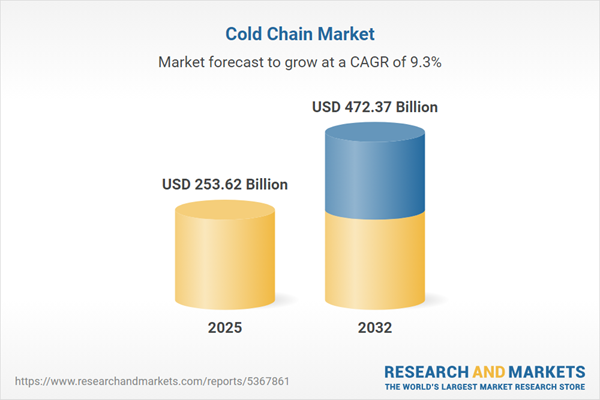Speak directly to the analyst to clarify any post sales queries you may have.
Effective cold chain management supports global supply chain resilience and compliance, enabling organizations to maintain operational integrity for sensitive goods. Senior executives require in-depth, actionable research to elevate their temperature-controlled logistics strategies and ensure sustained competitive advantage.
Market Snapshot: Cold Chain Market Size & Growth
The global cold chain market is undergoing significant expansion, growing from USD 232.44 billion in 2024 to USD 253.62 billion in 2025. Projections indicate the market will reach USD 472.37 billion by 2032, supported by a compound annual growth rate (CAGR) of 9.26%. Growth is influenced by evolving regulations, technological advancements, and the rise of cross-border trade. Key sectors, such as healthcare, food, and chemicals, are fueling substantial investments in reliable supply chain systems and improved transport security. Organizations are accelerating technology adoption, reinforcing traceability, and aligning with robust regulatory frameworks to meet strategic demands for temperature-sensitive logistics.
Scope & Segmentation of the Cold Chain Market
This report delivers segmentation and technology insights supporting informed decision-making for executives, allowing for prioritization of strategic investments and the optimization of supply chain operations. The following areas are comprehensively addressed:
- Temperature Range: Covers environments such as ambient, refrigerated, frozen, and cryogenic to address compliance and safeguard product integrity for sectors with diverse sensitivity needs.
- Equipment Type: Includes cold storage facilities, advanced refrigeration, insulated containers, and industrial freezers, each considered for their role in meeting quality standards and global distribution requirements.
- Service Model: Examines integration of IoT, GPS, RFID, and smart packaging to enable real-time visibility, improve traceability, and enhance logistics network efficiency.
- End User: Analyzes the specific operational and regulatory challenges for healthcare, pharmaceuticals, chemicals, and food and beverage, with a focus on reliability and risk management.
- Distribution Channel: Assesses in-house logistics and third- and fourth-party partnerships, highlighting approaches to achieve scalability, specialization, and responsive service for enterprise customers.
- Regional Coverage: Explores adoption patterns, infrastructure development, and investment landscapes in the Americas, Europe, Asia-Pacific, and the Middle East and Africa to guide regional strategy formulation.
- Key Companies Analyzed: Features detailed profiles of leading market participants, including Kuehne + Nagel International AG, DSV Panalpina A/S, United Parcel Service of America, FedEx Corporation, CEVA Logistics AG, Agility Public Warehousing Company K.S.C.P., Americold Real Estate Investment Trust, NICHIREI CORPORATION, Sonoco ThermoSafe, and Wabash National Corporation to support executive benchmarking and peer comparison.
Cold Chain Market: Key Takeaways for Senior Decision-Makers
- Deploying Internet of Things solutions and real-time tracking enables rapid visibility improvements, contributing to prompt responses to logistical disruptions and uniform product quality.
- Integrating automation and predictive analytics provides a foundation for adaptive compliance and safeguards high-sensitivity products in regulated industries, streamlining monitoring and incident response.
- Engaging in collaborative partnerships with logistics, packaging, and technology providers fosters comprehensive risk management and encourages sharing of operational expertise.
- Embedding sustainability initiatives, including energy-efficient technologies and renewable integration, supports organizational alignment with evolving responsibility and regulatory expectations.
- Increasing flexibility in procurement and operations helps organizations adapt swiftly to new policy frameworks and shifting market conditions, promoting agility in global supply chains.
United States Tariff Impact for 2025
Anticipated changes in United States tariff policy are prompting cold chain providers to refine procurement and delivery approaches. Decision-makers are leveraging flexible contracts, shipment consolidation, and advanced contingency plans to preserve supply stability and reduce risks associated with regulatory changes.
Methodology & Data Sources
This report combines secondary research, executive interviews, and targeted workshops to deliver actionable findings designed for C-suite leaders, strengthening enterprise risk assessment and strategic planning processes.
Why This Report Matters
- Equips executive teams to drive innovation in cold chain logistics through informed digital transformation, while supporting market resilience and compliance objectives.
- Enables organizations to proactively manage regulatory evolution, harness emerging technologies, and maximize efficiency in temperature-sensitive supply chains.
- Offers segmentation and regional insights to support competitor benchmarking, strategic evaluation, and improved global positioning.
Strategic Conclusion
Achieving growth in the cold chain market requires executives to prioritize technology integration, operational flexibility, and compliance. Focusing on these strategic pillars ensures organizations are prepared to excel in dynamic and regulated international environments.
Additional Product Information:
- Purchase of this report includes 1 year online access with quarterly updates.
- This report can be updated on request. Please contact our Customer Experience team using the Ask a Question widget on our website.
Table of Contents
3. Executive Summary
4. Market Overview
7. Cumulative Impact of Artificial Intelligence 2025
Companies Mentioned
The companies profiled in this Cold Chain market report include:- Kuehne + Nagel International AG
- DSV Panalpina A/S
- United Parcel Service of America, Inc.
- FedEx Corporation
- CEVA Logistics AG
- Agility Public Warehousing Company K.S.C.P.
- Americold Real Estate Investment Trust
- NICHIREI CORPORATION
- Sonoco ThermoSafe
- Wabash National Corporation
Table Information
| Report Attribute | Details |
|---|---|
| No. of Pages | 196 |
| Published | October 2025 |
| Forecast Period | 2025 - 2032 |
| Estimated Market Value ( USD | $ 253.62 Billion |
| Forecasted Market Value ( USD | $ 472.37 Billion |
| Compound Annual Growth Rate | 9.2% |
| Regions Covered | Global |
| No. of Companies Mentioned | 11 |









